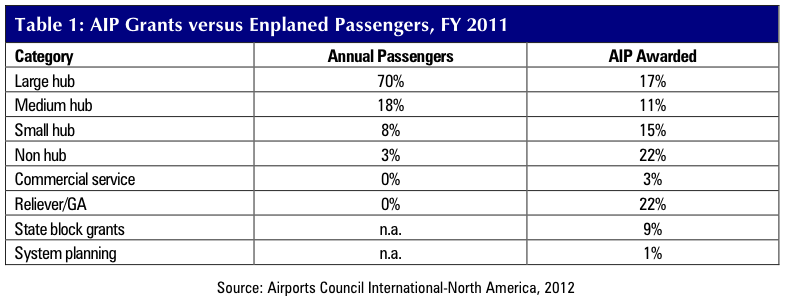REASON FOUNDATION
Overview
Transportation infrastructure is too important to the economy to be subject to across-the-board cuts in federal funding without first ensuring that alternate revenue streams are available. Ideally, each transportation mode should be made as self-supporting as possible via direct user fees. This would also make it feasible to use revenue-bond financing to do more reconstruction and new construction than would occur under the current policy of funding capital investment from operating cash flow. This approach would also tend to weed out projects whose benefits don’t significantly exceed their costs.
One inspiration for this policy brief is the report of the National Commission on Fiscal Responsibility and Reform (Simpson-Bowles Commission) in 2010. While its recommendations were not implemented, its proposals for transportation infrastructure reflected the above approach, including utilizing highway user tax revenues to make the Highway Trust Fund once again self- supporting, removing large and medium hub airports from the federal airport grants program to allow them to support themselves via passenger fees, and making inland waterway systems fully user-funded. This policy brief seeks to apply these users-pay/users-benefit principles more thoroughly to transportation infrastructure.
Problems with Current Federal Transportation Funding
The federal government assists the major modes of transportation via several systems of user taxes and trust funds:
- Highway users pay several federal user taxes (mostly on gasoline and diesel fuel) that support the Highway Trust Fund, from which grants are made for highway and transit programs.
- Air travelers pay a tax on airline tickets, and aircraft operators pay fuel taxes, with the proceeds of these and other user taxes feeding the Aviation Trust Fund, which pays for airport grants and for the capital costs and some of the operating costs of the air traffic control system.
- Ships unloading cargo at U.S. seaports pay a harbor maintenance tax, which streams into the Harbor Maintenance Trust Fund, from which funds are allocated for harbor dredging projects overseen by the Army Corps of Engineers.
- And users of U.S. inland waterways pay a diesel fuel tax for the Inland Waterways Trust Fund, which pays for a portion of the cost of maintaining and improving waterways, locks and dams.
While this approach sounds somewhat market-oriented, it fails to direct resources to their most productive use, for the following reasons:
- First, user taxes are still legally taxes. Seen as such, Congress is often reluctant to increase their levels, even though in many cases transportation infrastructure urgently requires additional investment.
- Second, each of the above programs builds in significant redistribution from some parts of the country to others, from some categories of users to others, and from general taxpayers to specific transportation modes, with political factors far outweighing any rigorous assessment of whether the economic benefits exceed the costs of the projects being funded.
- Third, federal involvement significantly increases the cost of building projects with federal money, via such policies as the Davis-Bacon Act, Buy America Act, the Jones Act, and other regulations and requirements.
- Fourth, since many of the federal grant programs focus on new capacity, decisions made by infrastructure owners tend to be biased in favor of more capital-intensive projects (e.g., light rail rather than bus rapid transit) than would be the case were they spending mostly their own money. This same focus on capital programs tends to encourage the ever-present temptation of state and local policymakers to under-invest in proper levels of maintenance in favor of creating more-politically desirable ribbon-cutting opportunities.
Another underlying problem is that the current federal grant funding approach has encouraged state and local infrastructure owners to fund most capital projects out of annual cash flow, rather than financing them. A basic principle of public finance is that long-lived infrastructure can and should be financed (i.e., capital should be raised up-front from the capital markets) and paid for over time, as the users of that infrastructure derive benefits from it. This is analogous to the way most people acquire their homes: not by saving until they can afford to pay cash, or building the home a room at a time as cash flow permits, but by taking out a long-term mortgage and paying it off over time, so as to obtain the benefits of home-ownership much sooner. Non-transportation infrastructure entities—electric and gas utilities, pipelines, telecommunications and water utilities—generally finance their major projects via revenue bonds, paid for by their users over many years. Railroads and toll roads do likewise, as do airports (to some extent) and air traffic control providers overseas. The United States is one of the few advanced developed countries that makes relatively little use of revenue-based financing for its transportation infrastructure.
Thus, the emerging and ongoing fiscal crisis of the federal government offers an opportunity to rethink how this country pays for and manages its critically important transportation infrastructure.
Read full report (PDF) here: Funding Important Transportation Infrastructure
About Reason Foundation
reason.org
“Reason Foundation advances a free society by developing, applying, and promoting libertarian principles, including individual liberty, free markets, and the rule of law. Reason Foundation produces respected public policy research on a variety of issues and publishes the critically-acclaimed Reason magazine. Together, our top-tier think tank and political and cultural magazine reach a diverse, influential audience, advancing the values of choice, individual freedom and limited government.”
Tags: Reason Foundation







 RSS Feed
RSS Feed